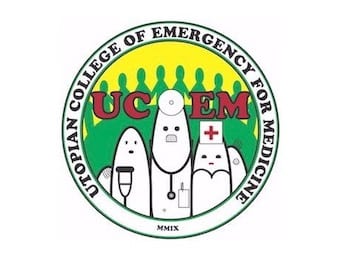
Downstairs Patients, Upstairs!
UCEM have enlisted the help of Dr. Scott Weingart (without his knowledge of course) to improve the care of patients presenting for assessment by Waiting Room Medicine subspecialists.

UCEM have enlisted the help of Dr. Scott Weingart (without his knowledge of course) to improve the care of patients presenting for assessment by Waiting Room Medicine subspecialists.

With the students mental welfare in mind, Prof Stickler uses his wry and perceptive sense of humour to great effect. For example, in the chapter on Bayesian inference his uproarious quote “10100111101101011101110001100110001100101011011010101010110100110000112” is still considered an exemplar of Euclidean literary miscellany within niche binary enclaves around the world.

Today, UCEM's Professor Stickler warned of the negative consequences of the current epidemic of methylphenidate and dexamphetamine used for the treatment of Attention Deficit/ Hypersensitivty Disorder (ADHD) in young people.

Funtabulously Frivolous Friday Five 359 - Just when you thought your brain could unwind, enter the medical trivia of FFFF.

Natural Killer Not Functioning to Combat Non-Presentation of MHC Due to Downstream Malfunction of Toll Like Receptor. A lesson in adaptive parasitology, and free parking. Full publication review from the Journal of Life as a Poor Science Analogy.

In social outings involving idiots, alcohol was found to protect neurons against apoptosis in smarter individuals. The delay in sensory relay caused by alcohol consumption is the likely mechanism for this phenomenon.

Prophylactic Euthanasia: a Public Health Initiative to Reduce the Future Burden of Disease. The ultimate transfer of responsibility over patients, and a final solution to morbidity.

Four years ago UCEM released a prophetic publication. Updated protocols to reduce the cost of care even further will save dollars, not lives
Biography Key Medical Contributions Major Publications References Biography

UCEM Publication: Initial trials with the PHAQ-OFF trial with initially promising results

We investigated to see which tools are the best detectors of artificial intelligence in medical writing. One tool was the clear winner, while others clearly struggled with accuracy!

Naxos disease: a recessively inherited condition with arrhythmogenic right ventricular dysplasia/ cardiomyopathy (ARVD/C) non-epidermolytic palmoplantar keratoderma, and woolly hair